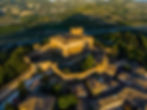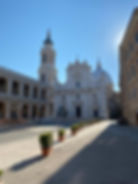Culture: Opera & Concerts
Le Marche has the highest concentration of theatres in the world.

Sferisterio, Province of Macerata
The region boasts a total of 113 theatres dating from the Renaissance to the 19th century which are of great interest to theatre and architecture enthusiasts alike. Le Marche also has the second largest open-air arena for opera in Italy - the Sferisterio based in the province of Macerata.
For music buffs there is one annual event which absolutely must not be missed. This is the annual Opera Festival in the glorious arena of the Sferisterio in Macerata. The quality of the performances is outstanding, and the venue is stunning. It is often compared favourably with the Arena di Verona, and the Caracalla in Rome.
The original sferisterio was built in the 15th century for local people to play and watch their favourite game of Pallone col Bracciale. The game involves wearing a wooden protection on the forearm (bracciale) which is used to hit the ball (pallone) back and forth. It is a little like Royal tennis, but teams can consist of between one and four players.
Players of this game in the 16th century were said to be the best paid athletes in Europe!
The Sferisterio was also used for circuses, and even bull fights! When the traditional game began to lose popularity the arena continued to be used for football , and also for tennis.
The modern arena was erected in the 1820s and has a wall 18 metres high and 88 metres long, with a line of arches separated by 56 columns carrying a double row of boxes and a stone gallery, all in neoclassical style. Opera was first performed here in 1914.
The Opera Festival itself began in 1921 with a performance of Verdi’s Aida, complete with horses and camels, funded by the leading soprano, Francisca Solari. In 1927 the superstar tenor Beniamino Gigli sang a benefit concert here for invalids of the Great War.
The present day festival, beginning in the late 1960’s under the auspices of Macerata Opera, takes place in the arena which has been modernised and provides all the necessary technology for a truly up to date theatrical experience. It seats over 3,500 people and the stage is huge – 14.5 metres deep and 40 metres wide – and the acoustics are wonderful.
The Festival
There are three or four operas performed during July and August each year, and the focus is on popular Italian Operas. The summer festival was started in 2006 when Pier Luigi Pizzi took over as artistic director.
The time of the operas was also changed so that the audience could also enjoy the spectacular sunset. Great names have sung here, including Pavarotti, Placido Domingo, Montserrat caballe, Jose Carreras, Fiorenza Cossotto – the list goes on! You can expect a truly world class evening’s entertainment here.
Home of Gioachino Rossini (1793 - 1868)
Probably the most famous of all the locally born celebrities was Gioacchino Rossini. Everyone has heard the overture to his opera William Tell, and, even in his lifetime he was a superstar. He was born on 29th February 1792 in Pesaro in the Marche, son of a slaughterhouse inspector and a baker’s daughter. But both his parents were also musicians and he grew up in a house full of music.
He showed musical talent very early and even wrote his first opera age 13 (though this was not staged until six years later)!
At the age of 14 he was sent to Bologna to study music at the Conservatory, and was nicknamed ‘il Tedeschino’ (the little German) because of his love of classical German composers. At the age of 18 he had his first opera staged in Venice. His career went from strength to strength and he became artistic director and resident composer at the Opera House in Naples at the tender age of 23. He remained in this post for seven years, producing 20 operas during this time, including The Barber of Seville and Cenerentola (Cinderella).
He lived and worked in London and Paris, but, after completing WilliamTell, he abandoned opera as a medium at the age of just 37, and returned to live in Bologna. After this time he composed very little, and only pieces for his own satisfaction, such as the beautiful Stabat Mater and a setting of the Mass (Le Petit Messe Solennelle).
He was married twice; first to the Spanish soprano, Isabella Colbran, who he lived with for a relatively short time, and after her death in 1846, he married the woman he had been living with for 15 years, Olympe Pelissier. She was a beautiful Parisian socialite and artists’ model and held popular cultural salons.
At the age of 63 he returned to Paris where he died on 13th November 1868. His remains were transferred to the Basilica di San Croce in Florence in 1887.
The Rossini Opera Festival, Pesaro
Pesaro, the birthplace of the composer, honours their illustrious son each year in August with a festival, encouraging revival and performance of his work in a unique setting. Operas are performed in the Teatro Rossini, an 850 seat theatre built in 1881, and also, more recently in the stadium which seats 1,500. This venue has been described as ‘one of the world’s most interesting and exciting opera houses’.
There are many other venues used for talks, plays and classes in the town, including a small studio theatre (Teatro Sperimentale) which is used during the festival to stage small scale works by lesser-known contemporaries of Rossini, such as Mosca and Generali. If you are an opera fan this festival offers a wonderful opportunity to see Rossini superbly performed in a glorious setting.

Gioacchino Rossini

















